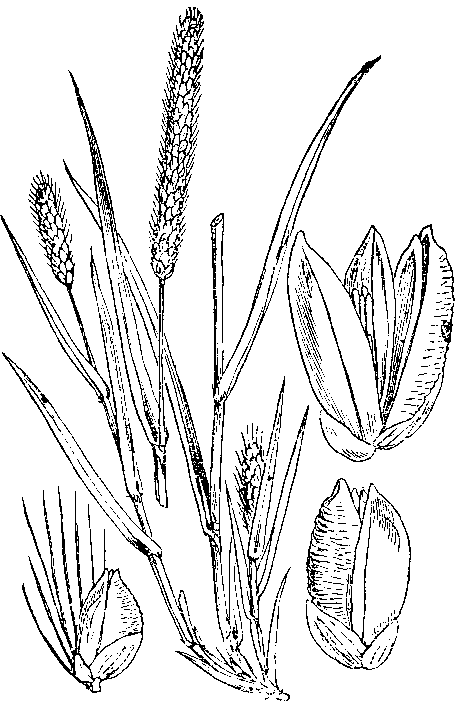 Pearl millet (Pennisetum glaucum) is the first if the four millets to be described in this series of posts. It is the most widely cultivated of the millets and the sixth most important grain worldwide. Being primarily a tropical and semi-arid land crop, it is not well known in the West. Probably first domesticated in Sahelian West Africa, it has spread throughout Africa and is also a major crop in South Asia, notably Rajasthan, India.
Pearl millet (Pennisetum glaucum) is the first if the four millets to be described in this series of posts. It is the most widely cultivated of the millets and the sixth most important grain worldwide. Being primarily a tropical and semi-arid land crop, it is not well known in the West. Probably first domesticated in Sahelian West Africa, it has spread throughout Africa and is also a major crop in South Asia, notably Rajasthan, India.
It is described in Lost Crops of Africa, PROTA4U, Feedipedia, and the ICRISAT site. In the US, pearl millet is mostly grown for animal feed, but I wonder about expanded cultivation as a food crop in drier or drought prone areas.
 Other English names for this grain include bulrush millet and cattail millet. It has names in the languages of regions that cultivate it, and of these, the most common are probably from the Indian subcontinent: alternately bajra (बाजरा ; Hindi, Punjabi ; باجرا Urdu) or bajri (बाजरी ; Rajasthani, Gujarati and Marathi) or variations thereof.
Other English names for this grain include bulrush millet and cattail millet. It has names in the languages of regions that cultivate it, and of these, the most common are probably from the Indian subcontinent: alternately bajra (बाजरा ; Hindi, Punjabi ; باجرا Urdu) or bajri (बाजरी ; Rajasthani, Gujarati and Marathi) or variations thereof.
West Africa
I personally got to know pearl millet/bajri first in Togo and then better while in Mali, where as in the rest of the Sahel it is a major crop and staple. It is commonly used in a “stiff porridge” (actually like a dough ball – in Bambara called to – pronounced toh; in African French, pâte) which is eaten with a sauce, as couscous, as a confection known as dɛgɛ (deh-geh; in French dégué), or in at least 2 kinds of (thin) porridge. For all of these it is pounded or milled to a flour – fine or coarse (other grains can be substituted, but obviously have their own taste). Staying with the Bambara examples:
- to is basically the fine flour cooked in water (with a lot of stirring)
- the Sahelian couscous (in Bambara there are several names, such as basi) is made with a coarser flour, steamed – same cooking process as for the internationally known wheat semolina-based Maghrebian couscous
- dɛgɛ is traditionally made from cooked millet, curds, sugar, and perhaps fruit of baobab
- mɔni is a lumpy loose porridge made from millet flour, with some of the flour rolled into small balls, and sugar
- seri is a porridge made with cracked millet, curds, and sugar
The Fulani in Mali also make a kind of dried couscous – lacciri joordi – combined with ground peanut/groundnut and perhaps pepper, to which water or milk can be added – sort of a fast food.
Also in West Africa, a millet beer is also made with pearl millet – less often in a Muslim Sahelian country like Mali than in a coastal one like Togo.
India
India is the largest producer of pearl millet in the world. The grain is a staple, one source referring to it as “the poor man’s staple.” However it is also used for non-food purposes such as fodder.
Bajra/bajri appears in various foods like bhakri bread, rotla/roti bread, and idli cakes – and certainly much more (my knowledge on this is limited). It is also exported.
In the U.S.
A year and half ago I found bajri flour in a local Indian market. The labeling did not make clear which kind of millet it was, but from the color I assumed it was pearl millet and was able to verify that online.
N’ye #saɲɔ mugu sɔrɔ Ɛndujamana-dumunifɛn-butiki dɔ la ( #FallsChurch, VA). #pearlmillet #petitmil #gawri #bajri pic.twitter.com/TBTTjQtLPJ
— Don Osborn (@donosborn) April 2, 2014
This was actually the first time I came across this grain in the U.S. Since then I’ve noticed it in some other international markets in Northern Virginia.
I’ve primarily used bajri in breakfast oatmeal – combining about 1/4 cup with just under 1 3/4 cups oatmeal to give it a different taste and texture. Also tried in pancakes with okay results. Eventually I plan to make a kind of lacciri. These are very limited experiments, really done by-the-way for some variety
Pearl millet/bajri is apparently grown in parts of the southern US, but mainly for animal feed. It would be interesting to know if any of the production is sold for food for people in the US, and in what forms it is used.
The next post in this series is “Four millets: 2. Finger millet, or ragi.”
